Why Does Bht (Butylated Hydroxytoluene Have Gelatin Is Is Animal Based?
Contents
- What is butylated hydroxytoluene
- Butylated hydroxytoluene in food
- Butylated hydroxytoluene biological and toxicological data
-
- Acute oral toxicity
- Genotoxicity
- Reproductive and developmental toxicity
- Hypersensitivity, allergy and intolerance
- Human studies: case studies
- Special studies on hemorrhagic effects
- Special studies on effects on the thyroid
- Summary
-
- Butylated hydroxytoluene MSDS
What is butylated hydroxytoluene
Butylated hydroxytoluene (2,6-Di-tert-butyl-four-methylphenol) likewise known every bit BHT or butylhydroxytoluene, is a synthetic α-tocopherol analogue antioxidant and preservative in the foods, cosmetics and pharmaceutical industry for scavenging hydrogen peroxide 1) . Butylated hydroxytoluene (BHT) is a white, crystalline solid which is odorless or has a faint aromatic odour. Butylated hydroxytoluene is insoluble in h2o, and freely soluble in ethanol and fat oils. It has a melting point of 70 °C and an octanol/water partition coefficient of five.one ii) . Co-ordinate to the Chancy Substances Data Bank HSDB 3) , butylated hydroxytoluene (BHT) is prepared in a multistep procedure by the reaction of p-cresol (4-
methylphenol) with high purity isobutylene (2-methylpropene) using an acrid catalyst. Upon neutralization by add-on of sodium carbonate, crystallization with isopropanol, filtration and washing with isopropanol, the substance is stale and sieved to obtain the final product.
During storage, food quality is reduced speedily considering of microbial spoilage and chemic reactions 4) . The most of import quality deterioration in the food systems is caused by chemical processes called lipid oxidation. In this process unsaturated fatty acids reacting with molecular oxygen via a gratuitous radical chain mechanism 5) . Equally a effect, hydroperoxides are formed which are unstable and decompose relatively quickly into aldehydes, ketones, alcohols, acids, esthers or hydrocarbons. These secondary oxidative products are responsible for food quality, nutrition, safety, color and consumers' acceptance 6) . The variables that affect the susceptibility of lipids to oxidation are temperature, fatty acrid composition, antioxidants, metals, enzyme-catalyzed reactions, and water vii) . In lodge to slow or command food's lipid oxidation, manufacturers employ antioxiative substances. The most ordinarily used are butyl hydroxyanisole (BHA), butylated hydroxytoluene (BHT), tertiary-butyl hydroquinone (TBHQ), and propylgalate past direct calculation them to nutrient products viii) .
Nowadays, active packaging which antioxidants are incorporated into packaging materials is an culling way for nutrient spoilage preservation ix) . It can avoid contacting between the substances and the food too as decrease the run a risk of adverse reactions 10) . Active packaging extends the shelf life of nutrient by preventing interacting of humidity or substances such every bit oxygen, ethylene, smell or unusual flavors with the food eleven) . For example, incorporation of synthetic antioxidants, such as butylated hydroxytoluene (BHT) and butyl hydroxyanisole (BHA) in polyethylene film, showed to protect the fresh beefiness colour from oxidation 12) . However, in recent years, at that place has been a growing interest in the utilise of natural antioxidants in food packaging applications such as green tea extract with fish gelatin films xiii) , brown algae extract with tuna-pare gelatin xiv) , essential oil 15) , tocopherols 16) , catechin-lysozyme 17) . Longan seeds and leaves have been employed as a good source of phenolic compounds, showing proficient antioxidant activity 18) .
Figure 1. Butylated hydroxytoluene (BHT)
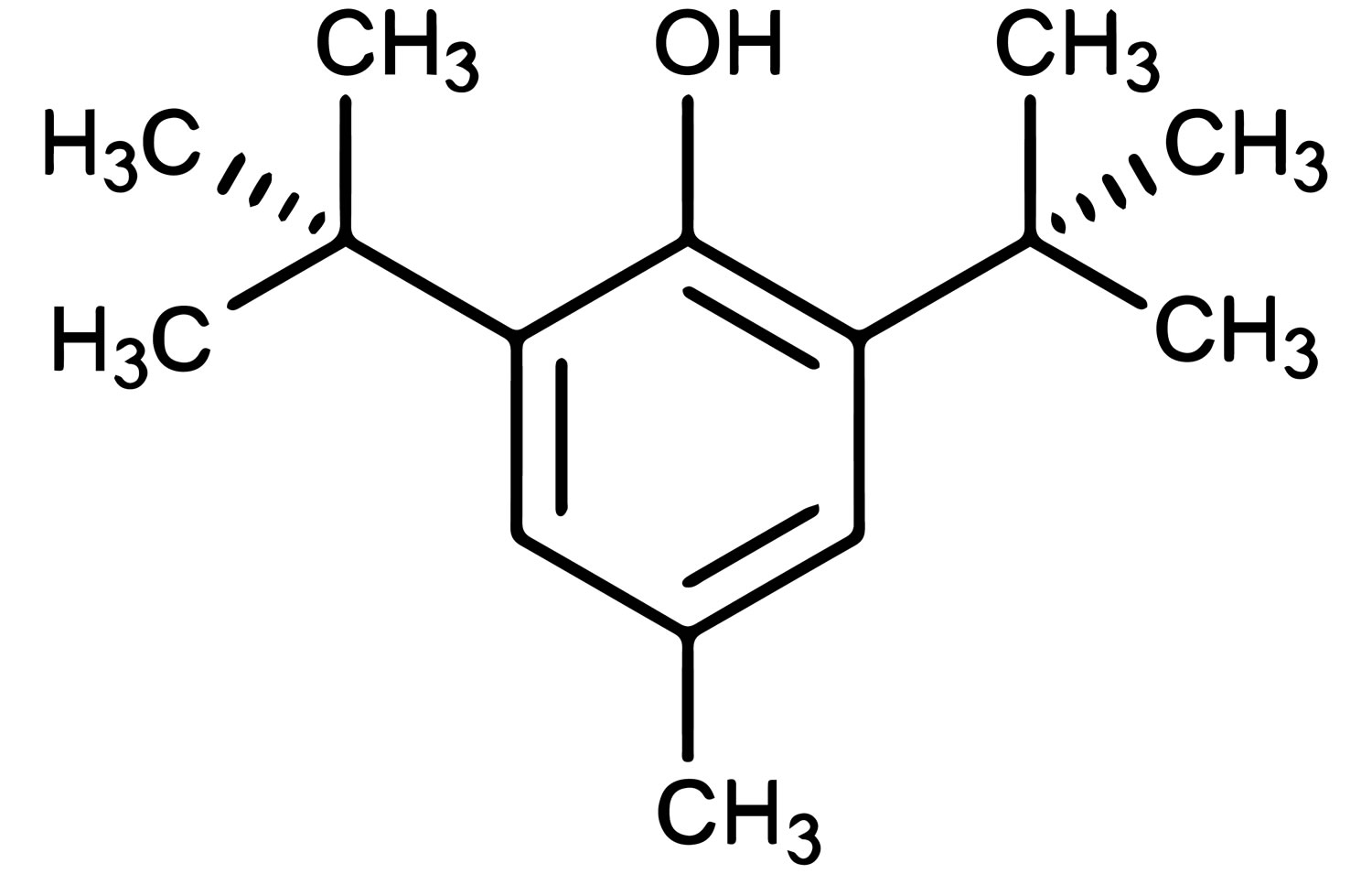
Butylated hydroxytoluene in food
Butylated hydroxytoluene (BHT) is a synthetic antioxidant authorized for use in fats and oils, only for the professional person manufacture of heat-treated food, in frying oil and frying fatty (excluding olive pomace oil) and in lard, fish oil, beefiness, poultry and sheep fat nineteen) . Butylated hydroxytoluene (BHT) is permitted lone or in combination with other antioxidants such as gallates, tert-butylhydroquinone (TBHQ) and butylated hydroxyanisole (BHA) in amounts upwardly
to 100 mg/kg expressed as fat. In improver, butylated hydroxytoluene (BHT) is permitted in chewing gum alone or in combination with the aforementioned antioxidants at a maximum level of 400 mg/kg chewing gum 20) .
No data on the bodily levels of butylated hydroxytoluene (BHT) in foods take been establish during literature searches in the databases ToxNet, PubMed and CAPlus, or on the web pages of the Food Standards Agency of Britain. The Danish Veterinary and Food Administration has reported a project on monitoring and control of food additives in which butylated hydroxytoluene (BHT) levels were analyzed in 122 samples of emulsified and not-emulsified sauces (dressings, ketchup etc.) and fruit- and vegetable preparations (chutney, tomato plant paste etc.). Butylated hydroxytoluene (BHT) was non identified in whatsoever of these samples 21) .
When scrutinizing ingredient lists on various chewing gums on the Danish market, butylated hydroxytoluene (BHT) is not mentioned in the list of ingredients on every brand. Hence, it can be deduced that chewing gum may be manufactured without the use of butylated hydroxytoluene (BHT). In a survey past Bemrah et al. 22) 1 out of 28 chewing gum brands was found to contain 200 mg butylated hydroxytoluene/kg, whereas the residuum contained no butylated hydroxytoluene (BHT).
Additional data on reported use levels of use for butylated hydroxytoluene was fabricated available to the Console by FoodDrinkEurope. For the food categories "fats and oils for the professional person manufacture of heat-treated foodstuffs" and for "lard, fish oil, beef, poultry and sheep fat" the data made bachelor are listed in Table 1. For other food categories where the use of butylated hydroxytoluene is authorized, FoodDrinkEurope either reported that no data were received from their membership or that these categories are not representatively covered past FoodDrinkEurope's membership. Butylated hydroxytoluene (BHT) is also used in nutrient contact materials with a specific migration limit of 3 mg/kg nutrient (Commission Regulation 10/201111).
Tabular array 1. Maximum Permitted Levels of butylated hydroxytoluene (BHT) in foodstuffs according to Directive No 95/2/EC and maximum reported use levels of BHT in foodstuffs used for the refined exposure assessment
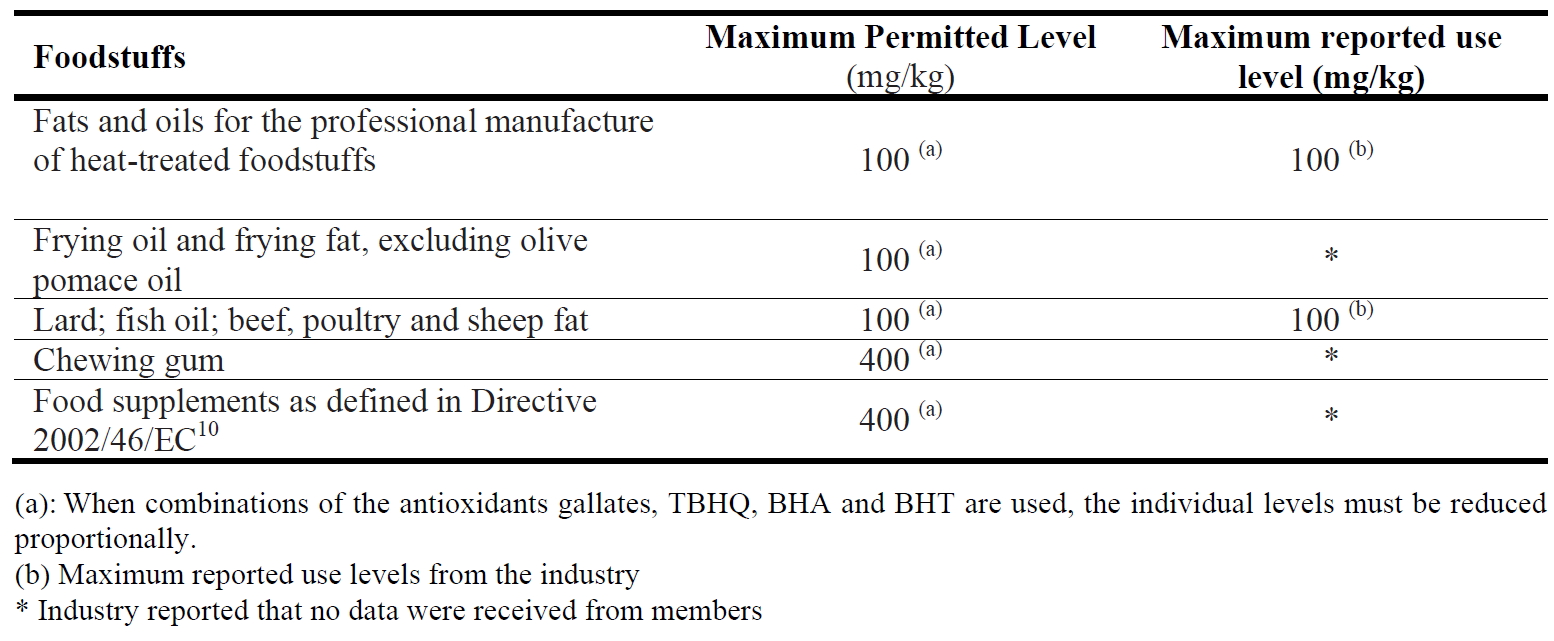
[Source 23) ]
Table 2. Summary of predictable exposure to butylated hydroxytoluene (BHT) from its use equally food additive using maximum reported use levels for four population groups

[Source 24) ]
Table two summarizes the estimated exposure to butylated hydroxytoluene (BHT) from its employ as food additive of all 4 population groups. An exposure to butylated hydroxytoluene from the consumption of chewing gum using the Maximum Permitted Level for this food category of 400 mg/kg would require a daily intake of 7.5 chiliad of chewing glue to reach a level of 0.05 mg butylated hydroxytoluene (BHT)/kg body weight/day. Unfortunately, very express information were available for the consumption of this nutrient category in the Comprehensive Database since simply few consumers in some countries reported information on chewing gum consumption. Information technology also has to exist considered that non all butylated hydroxytoluene (BHT) nowadays in chewing gum volition be ingested. Information technology was concluded that 80-99% of butylated hydroxytoluene (BHT) in chewing mucilage is not ingested 25) , but ingestion may be higher given that higher levels of extraction of upwardly to fifty% were as well found in 1 study 26) . Assuming a 10% extraction and subsequent ingestion of butylated hydroxytoluene (BHT) from chewing gum and selecting only those surveys with a sufficiently high number of consumers, the average exposure to butylated hydroxytoluene (BHT) from chewing glue consumption is in the range of 0-0.003 mg/kg body weight/twenty-four hour period for children, 0-0.002 mg/kg body weight/day for adolescents and 0-0.004 mg/kg body weight/day for adults (consumers only). At the 95th percentile, exposure to butylated hydroxytoluene (BHT) from chewing gum consumption is in the range of 0.004-0.008 mg/kg trunk weight/mean solar day for children, 0.003-0.006 mg/kg bw/twenty-four hours for adolescents and 0.004-0.008 mg/kg body weight/twenty-four hour period for adults.
Using a worst instance scenario of combined exposure to butylated hydroxytoluene (BHT) from food categories where its use as food additive is authorized, the European Food Safety Authority (EFSA) Panel estimated potential exposure to exist in the range of 0.01-0.03 mg/kg body weight/mean solar day on average and 0.03-0.17 mg/kg torso weight/day at the 95th percentile for adults. For adolescents, combined exposure to butylated hydroxytoluene (BHT) from all food categories would be on average in the range of 0.01-0.05 mg/kg body weight/twenty-four hour period and in the range of 0.04-0.13 mg/kg body weight/day at the 95th percentile. For children, combined exposure to butylated hydroxytoluene (BHT) from all food categories would be on average in the range of 0.01-0.09 mg/kg body weight/day and in the range of 0.05-0.30 mg/kg torso weight/mean solar day at the 95th percentile. Exposure to butylated hydroxytoluene (BHT) from its use in food contact materials with a specific migration limit of three mg/kg nutrient and the supposition that every 24-hour interval throughout lifetime a person weighing 60 kg consumes 1 kg of food packed in plastics containing butylated hydroxytoluene (BHT) in the maximum permitted quantity would be increased by 0.05 mg/kg body weight/day. Assuming that children weighing 15 kg also consume 1 kg of food packed in plastics containing butylated hydroxytoluene (BHT) in the maximum permitted quantity, exposure to butylated hydroxytoluene (BHT) of children would be increased by 0.two mg/kg trunk weight/day.
The European Wedlock Scientific Committee for Food (SCF) established an Acceptable Daily Intake (ADI) for butylated hydroxytoluene (BHT) of 0-0.05 mg/kg body weight/day based on thyroid, reproduction and hematological effects in the rat. Acceptable Daily Intake (ADI) is an estimate of the amount of a food condiment that can exist ingested daily over a lifetime without appreciable wellness risk. The Articulation FAO/WHO Proficient Committee on Nutrient Additives (JECFA) allocated an ADI of 0-0.3 mg/kg trunk weight/mean solar day for butylated hydroxytoluene (BHT) based on effects in the reproduction segments and hepatic enzyme consecration seen in ii separate 2-generation studies in rats. The European Food Safety Authorisation (EFSA) Console concluded that butylated hydroxytoluene (BHT) is not of business organisation with respect to genotoxicity and that whatsoever carcinogenicity would be thresholded. After the last European Union Scientific Committee for Food (SCF) evaluation, two new two-generation studies have been reported which were the basis for the ADI fix by Joint FAO/WHO Expert Committee on Nutrient Additives (JECFA). Both studies revealed a No-observed-adverse-result level (NOAEL) of 25 mg/kg body weight/day. No-observed-adverse-upshot level (NOAEL) is the greatest concentration or amount of a substance, found by experiment or ascertainment, that causes no detectable adverse alteration of morphology, functional chapters, growth, development, or lifespan of the target organism under defined conditions of exposure. Overall, the European Food Condom Dominance (EFSA) Panel concluded that the present database gives reason to revise the ADI of 0.05 mg/kg body weight/day. Based on the NOAEL of 25 mg/kg body weight/day and an uncertainty factor of 100, the European Nutrient Safety Authority (EFSA) Panel derived an ADI of 0.25 mg/kg body weight/24-hour interval. Since the NOAEL of 25 mg/kg body weight/twenty-four hours is below the BMDL10 value of 247 mg/kg trunk weight/day derived from the data for the incidence of hepatocellular carcinomas (liver cancers) in male person rats, the European Food Safe Authorisation (EFSA) Panel concluded that this NOAEL as well covers the hepatocellular carcinomas observed in the long-term studies with butylated hydroxytoluene (BHT). Exposure of adults to butylated hydroxytoluene (BHT) is unlikely to exceed the newly derived Acceptable Daily Intake (ADI) at the mean and at the 95th percentile. Benchmark dose (BMD) is defined as the dose that corresponds to a specific modify in an adverse response compared to the response in unexposed subjects and the lower 95% conviction limit is termed the benchmark dose level (BMDL). For exposure of children to butylated hydroxytoluene (BHT) from its apply as food additive, the European Food Safety Authority (EFSA) Panel noted that it is also unlikely that this ADI is exceeded at the mean, simply is exceeded for some European countries (Finland, The Netherlands) at the 95th percentile.
Butylated hydroxytoluene biological and toxicological data
In one study in humans the urinary metabolites butylated hydroxytoluene (BHT)-COOH (the "acrid") and benzoyl-glycine (hippuric acrid) were institute afterwards ii split oral doses of 100 mg butylated hydroxytoluene (BHT), and in another study butylated hydroxytoluene (BHT)-COOH and its glucuronide ester were the merely major metabolites identified in urine after an oral dose of i.0 g 27) . In 2 men, excretion of a single oral dose of xl mg/kg [14C] butylated hydroxytoluene (BHT) was 50% in the beginning 24 hours, followed by slower excretion for the side by side 10 days. In total, 63-67% of the dose was excreted in the urine after 10 days. Fecal excretion was measured in one human and was found to be 0.iii% of the dose per day initially, and waning off to 0.02% of the dose per solar day, 31 days later on dosing 28) .These studies bear witness that butylated hydroxytoluene (BHT) is rapidly absorbed from the gastrointestinal tract and distributed. Upon absorption, butylated hydroxytoluene (BHT) is more often than not distributed to the liver and torso fatty. Excretion is mainly via urine and feces. The metabolism of butylated hydroxytoluene (BHT) is complex. There may exist important species differences. Information technology is not known for example whether humans are capable of forming the quinone methides, metabolites that were found in rats and mice. In addition, biliary excretion seems non to be as significant in man as information technology is in rats, rabbits and dogs.
Acute oral toxicity
According to the results of astute toxicity studies with butylated hydroxytoluene (BHT) reported to JECFA 29) , butylated hydroxytoluene (BHT) possesses low acute toxicity. The acute oral LD50 of butylated hydroxytoluene (BHT) was 1700-1970 mg BHT/kg trunk weight in rats, 2100-3200 mg butylated hydroxytoluene (BHT)/kg body weight in rabbits, 10,700 mg BHT/kg body weight in guinea pigs, 940-2100 mg BHT/kg trunk weight in cats, and 2000 mg BHT/kg bw in mice 30) .
Curt-term or subchronic exposure to butylated hydroxytoluene (BHT) affects the liver of mice, rats and chickens, as well showing histopathological changes in this organ. In add-on, BHT has been shown to increase the relative thyroid and adrenal weight in rats. Newer data show an α-tocopherol sparing effect in rats.None of the studies available could be used to derive a No-observed-adverse-effect level (NOAEL).
Genotoxicity
The genotoxicity of butylated hydroxytoluene (BHT) has been studied in several in vitro systems 31) and an extensive database of genotoxicity studies for butylated hydroxytoluene (BHT) was reviewed past Bomhard et al. 32) and by Williams et al. 33) . These authors ended that the majority of evidence indicated a lack of potential for butylated hydroxytoluene (BHT) to induce signal mutations, chromosomal aberrations, or to interact with or impairment DNA, and that butylated hydroxytoluene (BHT) does not correspond a genotoxic run a risk.
TemaNord 34) reported that butylated hydroxytoluene (BHT) was not genotoxic in vivo in rats at oral doses up to 500 mg/kg body weight (ascendant lethal assay) or in mice at doses of i% in the feed (approximately thousand mg/kg trunk weight/day) (dominant lethal and heritable translocation assays).
In general, the genotoxicity studies on butylated hydroxytoluene (BHT) show that the majority of evidence indicates a lack of potential for butylated hydroxytoluene (BHT) to induce point mutations, chromosomal aberrations, or to interact with or damage Deoxyribonucleic acid. The European Nutrient Safety Authority (EFSA) Panel recognized that positive genotoxicity results obtained in vitro with butylated hydroxytoluene (BHT) and butylated hydroxytoluene (BHT) metabolites may be due to pro-oxidative chemistry giving rise to germination of quinones and reactive oxygen species and that such a mechanism of genotoxicity is by and large considered to take a threshold.
The International Agency for Research on Cancer 35) evaluated butylated hydroxytoluene (BHT) and classified information technology in grouping 3, since no evaluation could be made of the carcinogenicity of butylated hydroxytoluene (BHT) to humans, and at that place was
express bear witness for the carcinogenicity in experimental animals. Williams et al. 36) accept reviewed information on genotoxicity and carcinogenicity of butylated hydroxytoluene (BHT) including reports which appeared subsequent to the International Agency for Research on Cancer 37) evaluation. Williams et al. 38) argued that butylated hydroxytoluene (BHT) is not genotoxic or carcinogenic; they particularly argued that the carcinogenicity in rats institute in the study by Olsen et al. 39) has not been confirmed in other studies with rats, and that the effects found may be attributable to study conditions and non to the administration of butylated hydroxytoluene (BHT). They too point out that a more recent study forty) dosing Wistar rats for up to xviii months with 0.1% 2,2'-methylenebis (4-methyl-6-tertbutylphenol), an antioxidant which is essentially ii molecules of butylated hydroxytoluene (BHT) and has all the attributes of butylated hydroxytoluene (BHT), did not result in a carcinogenic response.
The European Food Prophylactic Authorisation (EFSA) Panel concluded that butylated hydroxytoluene (BHT) in high doses can exert tumor-promoting effects in some fauna models. The data do non allow the establishment of a NOAEL for a carcinogen-promotional effect.
The clan between dietary intake of butylated hydroxytoluene (BHT) and stomach cancer run a risk was investigated in holland Accomplice Written report (NLCS) that started in 1986 amidst 120 852 men and women anile 55-69 years. A semi-quantitative food frequency questionnaire was used to assess food consumption.
Data on butylated hydroxytoluene (BHT) content of cooking fats, oils, mayonnaise and other creamy salad dressings and dried soups was obtained by chemical analysis, a Dutch database of food additives (ALBA) and the Dutch Compendium of Foods and Nutrition Products. After half dozen.3 years of follow-upward, complete information on butylated hydroxyanisole (BHA) and butylated hydroxytoluene (BHT) intake of 192 incident tum cancer cases and 2035 sub-cohort members were bachelor for case-cohort analysis. Mean intake of butylated hydroxytoluene (BHT) amidst sub-cohort members was 0.351 mg/day. No association with breadbasket cancer risk was observed for consumption of mayonnaise and other creamy salad dressings with butylated hydroxytoluene (BHT). A statistically non-significant decrease in stomach cancer risk was observed with increasing BHA and butylated hydroxytoluene (BHT) intake. No significant clan with stomach cancer take chances was found in this study, for normal dietary intake of low levels of butylated hydroxytoluene (BHT) 41) .
In decision, lung or liver tumors take been seen in some studies in mice or rats exposed orally to butylated hydroxytoluene (BHT) as the single exam substance. BMD analyses of the information reported by Brooks et al. 42) on the incidence of lung neoplasia in mice induced past butylated hydroxytoluene (BHT) revealed a BMDL10 of 38 mg/kg body weight/day, and of the data reported by Olsen et al. 43) on the incidence of hepatocellular carcinomas in male rats induced by butylated hydroxytoluene (BHT) a BMDL10 of 247 mg/kg body weight/twenty-four hour period. The NOAEL for non-neoplastic furnishings in the study of Olsen et al. 44) was 25 mg/kg bw/day, based on the effects on litter size, sex ratio and pup trunk weight proceeds during the lactation catamenia in the reproduction segment of the study.
Reproductive and developmental toxicity
Studies on reproductive toxicity have been reported in mice, rats, chickens and monkeys 45) . In a study past Eriksson and Siman 46) , pregnant diabetic and normal Sprague-Dawley rats were fed as required either a standard diet or a diet with 1% of butylated hydroxytoluene (BHT) (estimated to be equivalent to approximately 500 mg/kg trunk weight/day). The fetuses of the diabetic rats (ii.70 chiliad trunk weight) were smaller than the fetuses of the normal rats (three.68 one thousand) when the mothers were fed a standard nutrition. The butylated hydroxytoluene (BHT) diet increased the fetal weight in the offspring of diabetic rats (3.17 yard), with no change in fetuses of the normal rats (three.65 grand). The placentas of diabetic rats were heavier than the placentas of normal rats; this difference was not present in the butylated hydroxytoluene (BHT)-fed rats. The butylated hydroxytoluene (BHT) handling had no issue on the rate of resorptions, which was increased in the diabetic rats compared with the normal rats. In dissimilarity, the increased rate of congenital malformations in the offspring of diabetic rats (xix%), compared with that in the normal rats (0%), was markedly decreased by the butylated hydroxytoluene (BHT) diet (ii.three%). No malformations were found in the normal rats treated with butylated hydroxytoluene (BHT). The European Food Safety Authority (EFSA) Panel considered that the merely dose level of butylated hydroxytoluene (BHT) tested in this study of 500 mg/kg body weight/day tin can be considered a NOAEL.
Hypersensitivity, allergy and intolerance
Two patients with chronic idiopathic urticaria were subjected to double-blind, placebo-controlled, oral challenges with a series of food additives. During testing, butylated hydroxytoluene (BHT) and butylated hydroxyanisole (BHA) were identified as causative agents. Avoidance of foods containing butylated hydroxytoluene (BHT) and BHA resulted in long-term reduction in severity and frequency of urticarial episodes 47) .
In a double-blind placebo controlled report by Hannuksela and Lahti 48) with challenge tests of 44 patients with chronic urticaria, 91 with atopic dermatitis and 123 with contact dermatitis, none reacted to butylated hydroxytoluene (BHT) when it was ingested in a capsule containing 50 mg butylated hydroxytoluene (BHT).
Signs of contact dermatitis after dermal exposure to butylated hydroxytoluene (BHT) and allergic reactions after oral intake of a mixture of butylated hydroxytoluene (BHT) and butylated hydroxyanisole (BHA) were occasionally reported 49) . In another report (Goodman et al., 1990), two patients with chronic
idiopathic urticaria adult exacerbations when challenged with butylated hydroxytoluene (BHT)/butylated hydroxyanisole (BHA), but had less symptomsafter cons uming a butylated hydroxytoluene (BHT)/butylated hydroxyanisole (BHA)-gratuitous nutrition.
When patch-tested on more than than 15 individuals, butylated hydroxytoluene (BHT) showed mild skin irritation; a positive skin reaction 14 days afterwards was interpreted equally sensitization l) .
Recent patch examination results obtained from the medical surveillance of slap-up numbers of workers51) or patients 52) were all negative.
The European Food Safety Say-so (EFSA) Panel noted that these limited reports do not let whatsoever conclusions to be drawn about sensitization to butylated hydroxytoluene (BHT) post-obit oral intake.
Human studies: example studies
Shilian and Goldstone 53) reported a case of gastritis caused past ingestion of butylated hydroxytoluene (BHT) in a 22-year-erstwhile adult female who ingested iv grand of butylated hydroxytoluene (BHT) on an empty tum two days before the onset of the gastritis. This amounts to an acute dose of about 67 mg/kg bw assuming a body weight of threescore kg. Later that evening she experienced severe epigastric cramping, generalized weakness, nausea and vomiting, followed by dizziness, confusion and a brief loss of consciousness.
A like case written report was reported by Grogan 54) . A 24-year-one-time woman complained of lightheadedness, unsteadiness of gait and slurred speech. On examination the following findings were noted: dysarthria, broad-based gait, a positive Romberg test, slowed mentation without thought disorder and dysmetria of the left (non-dominant arm). On the evening earlier admission the patient ingested eighty grams of butylated hydroxytoluene (BHT) suspended in safflower oil on an empty tummy. This dose is estimated to be equivalent to nigh 1.3 g/kg bw, bold a lx kg body weight.
Special studies on hemorrhagic effects
The European union Scientific Commission for Food (SCF) 55) concluded that a series of studies has shown that some, but non all species tested testify hemorrhage and/or a reduction in blood prothrombin index later dosing with butylated hydroxytoluene (BHT). The mechanisms by which butylated hydroxytoluene (BHT) brings about these effects announced to be several but the major event is a reduction in activity of certain clotting factors, principally those which are vitamin Thou-dependent. The most susceptible species for hemorrhagic effects appears to be the rat, and for this species the NOAEL for transient reduction (1 calendar week elapsing) of the prothrombin alphabetize was approximately ix mg/kg body weight/24-hour interval, and for persistent reduction (four week duration), approximately 250 mg/kg body weight/day given with the diet. Chickens may besides answer with hemorrhage of the liver 56) .
Administration to groups of five male Slc:ddY mice of 0.five%, ane.0% or 2.0% butylated hydroxytoluene (BHT) in a purified diet (equivalent to 660, 1390 or 2860 mg/kg trunk weight/day) for 21 days resulted in a dose-related increment in the mortality due to massive haemorrhage in the lungs 57) .
Administration to groups of five male Slc:ddY mice of 0.five%, 1.0% or two.0% butylated hydroxytoluene (BHT) in a purified diet (equivalent to 660, 1390 or 2860 mg/kg body weight/day) for 21 days resulted in a dose-related increase in the bloodshed due to massive hemorrhage in the lungs 58) .
Special studies on effects on the thyroid
Rats were fed 0, 500 or 5000 mg butylated hydroxytoluene (BHT)/kg of feed (estimated to be equivalent to approximately 25 or 250 mg/kg bw/day) for 8, 26 or 90 days and the uptake of 125I by the thyroid was adamant. The presence of butylated hydroxytoluene (BHT) in the diet resulted in a marked increase in the uptake of 125I at all time periods studied. When rats were fed butylated hydroxytoluene (BHT) in diets containing varying amounts of iodine (0.12, 0.xv or 0.3 mg iodine/kg feed) for 30 days, at that place was a pregnant increase in thyroid weight in butylated hydroxytoluene (BHT) treated animals when compared to controls. butylated hydroxytoluene (BHT) did not alter levels of T3 and T4 in the blood. The biological half-life of thyroxine was increased after 13 days on a butylated hydroxytoluene (BHT) nutrition but returned to normal afterward 75 days. Electron microscopy of the thyroid glands of rats exposed to 250 mg butylated hydroxytoluene (BHT)/kg bw/day for 28 days showed an increase in the number of follicle cells 59) .
Based on this ascertainment the European Food Safety Authority (EFSA) Panel noted that the NOAEL of this written report would be 25 mg/kg body weight/day.
Although rodents and humans share a common physiology in regard to the thyroid-pituitary feedback organisation, a number of factors contribute to the greater sensitivity of the rat to long-term perturbation of the pituitary thyroid axis which predisposes it to a higher incidence of proliferative lesions in response to chronic TSH stimulation than human being thyroid.
Both humans and rodents take nonspecific low affinity protein carriers of thyroid hormone (e.g., albumin). Notwithstanding, in humans, other primates, and dogs there is a high affinity binding poly peptide, thyroxine-bounden globulin (TBG), which binds T4 (and T3 to a bottom degree); this protein is not nowadays in rodents, birds, amphibians and fish, and has a m-fold greater bounden affinity than nonspecific low affinity protein carriers.
Although qualitatively the rat is an indicator of a potential human thyroid cancer take a chance, humans announced to be quantitatively less sensitive than rodents to developing cancer from perturbations in thyroid-pituitary condition. Given that the rodent is a sensitive model for measuring the carcinogenic influences of TSH and that humans appear to be less responsive, effects on rodents would represent a conservative indicator of potential take chances for humans. Rodent cancer studies typically include doses that atomic number 82 to toxicity, including perturbation in thyroid-pituitary office over a lifetime. The relevance of the experimental weather to predictable human exposure scenarios (i.e., dose, frequency and fourth dimension) should be considered. In addition, chemically-induced effects that are produced by brusque-term disruption in thyroid-pituitary part appear to exist reversible, when the stimulus is removed.
Summary
Butylated hydroxytoluene (BHT) is a synthetic antioxidant authorized as a food additive in the European Union that was previously evaluated past the European union Scientific Committee for Nutrient (SCF) in 1987 and the Joint FAO/WHO Practiced Commission on Nutrient Additives (JECFA) several times, the latest in 1996.
The European Nutrient Safety Authority (EFSA) Panel ended that the present database justifies the revision of the Adequate Daily Intake (ADI) of 0-0.05 mg/kg body weight/day gear up by the European union Scientific Commission for Food (SCF).
Based on a No-observed-adverse-effect level (NOAEL) of 25 mg/kg body weight/day from two ii-generation studies in rats and an dubiety factor of 100, the European Food Safety Authority (EFSA) Panel derived an ADI of 0.25 mg/kg body weight/mean solar day.
Since the NOAEL of 25 mg/kg torso weight/twenty-four hours for the reproductive effects is below the BMDL10 values for hepatocellular carcinomas in long-term studies with butylated hydroxytoluene (BHT), the Panel concluded that this NOAEL likewise covers this effect.
The European Food Safety Potency (EFSA) Panel noted that exposure of adults to butylated hydroxytoluene (BHT) from its utilise as nutrient additive is unlikely to exceed the newly derived Adequate Daily Intake (ADI) of 0.25 mg/kg body weight/day at the mean and for the high consumers (95th percentile). Exposure of children to butylated hydroxytoluene (BHT) from its use as food additive is likewise unlikely to exceed this ADI at the hateful, but is exceeded for some European countries (Finland, Kingdom of the netherlands) at the 95th percentile. If exposure to butylated hydroxytoluene (BHT) from its employ as food contact material is likewise taken into account the new ADI would exist exceeded by children at the mean and at the 95th percentile.
Butylated hydroxytoluene MSDS
Butylated hydroxytoluene solubility:
- less than 1 mg/mL at 68° F (20 °C).
- Insoluble in water and propane- ane,ii-diol;
- Freely soluble in ethanol
- Freely soluble in toluene; soluble in methanol, isopropanol, methyl ethyl ketone, acetone, cellosolve, benzene, nearly hydrocarbon solvents, ethanol, petroleum ether, liquid petrolatum (white oil): 0.five% wt/wt; more sol in food oils and fats than butylated hydroxyanisol; good solubility in linseed oil. Insoluble in propylene glycol 60)
- Soluble in ethanol, acetone, benzene, petroleum ether; Insoluble in alkali 61)
- Soluble in naphtha; insoluble in 10% sodium hydroxide 62)
- In water, 0.6 mg/L at 77° F (25 °C) 63)
- In water, 0.4 mg/Fifty at 68° F (xx °C)
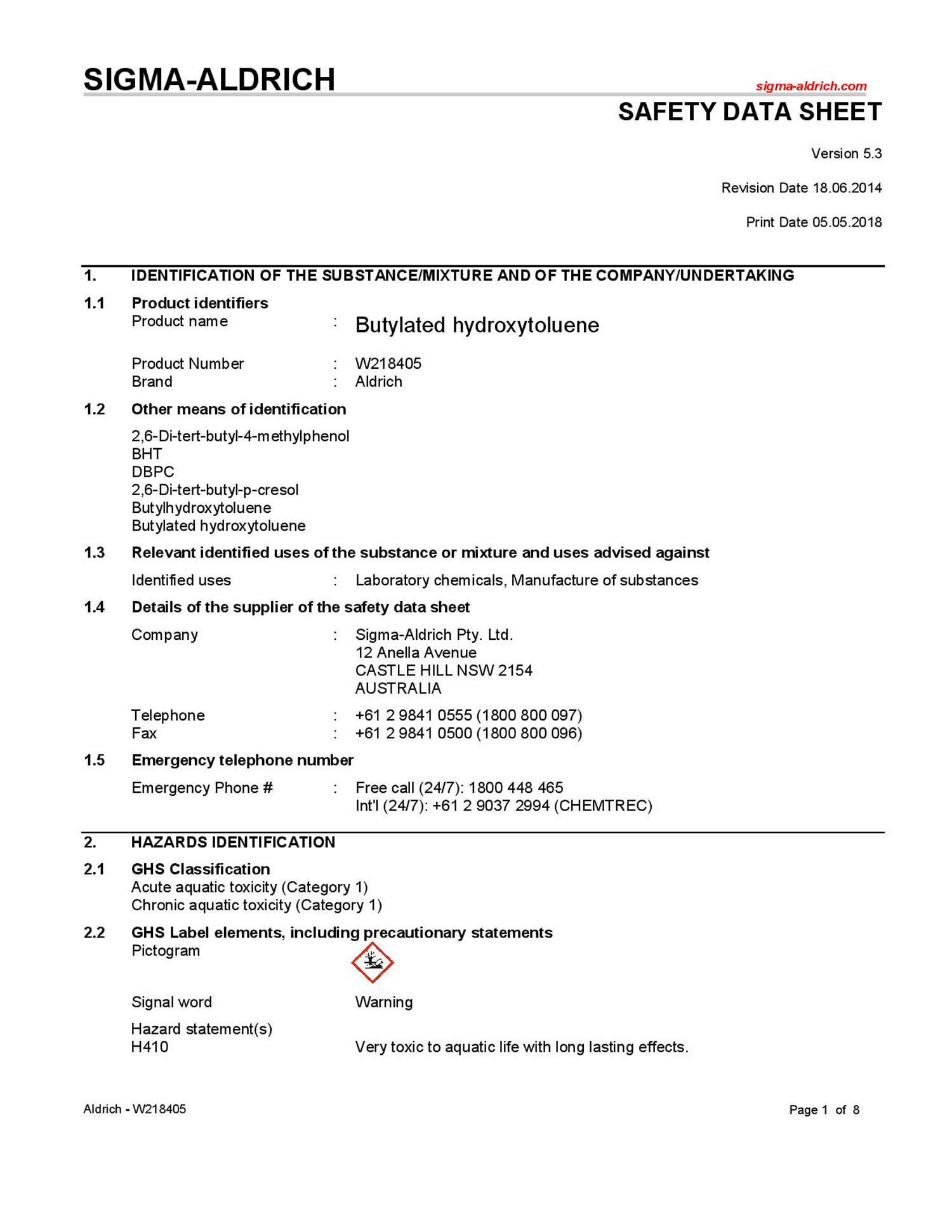
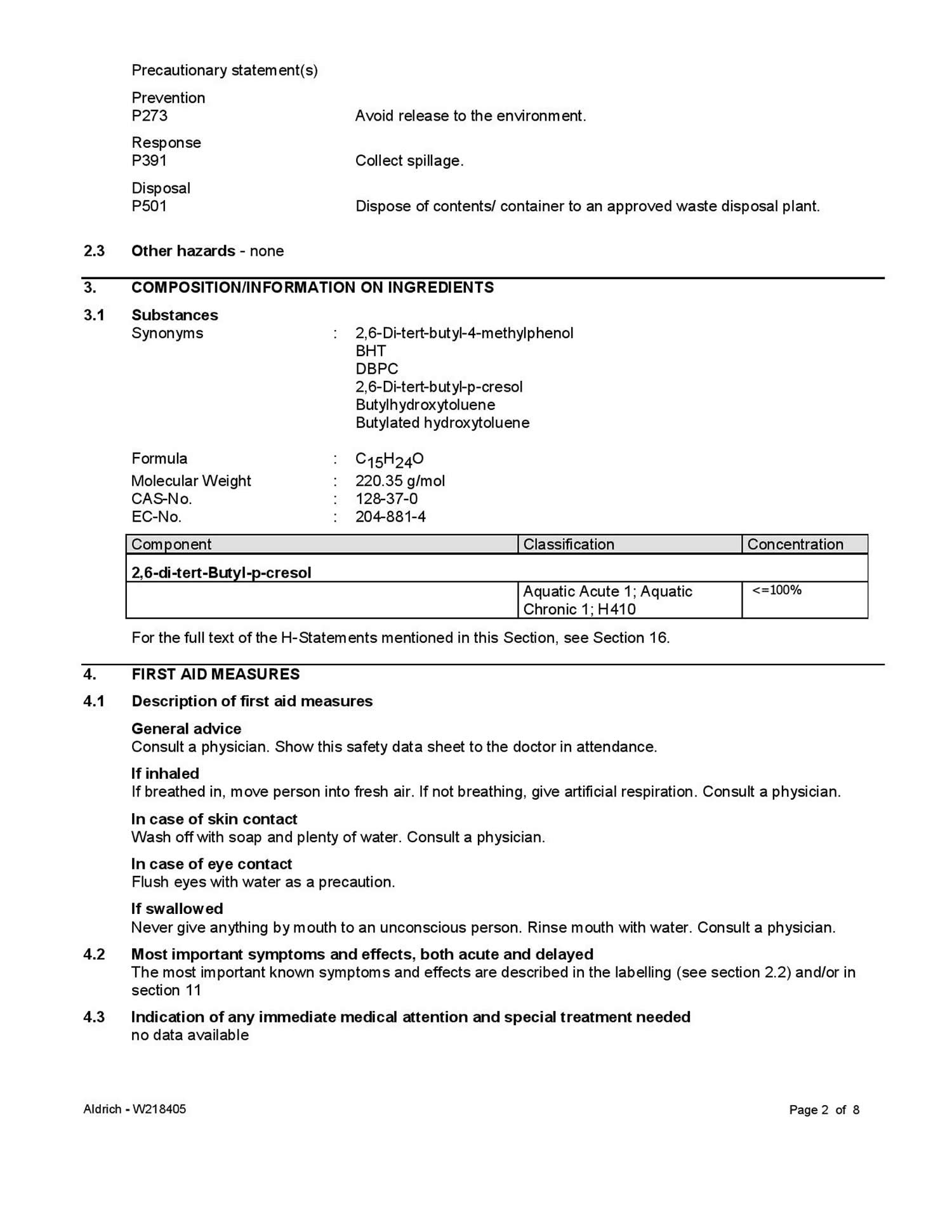

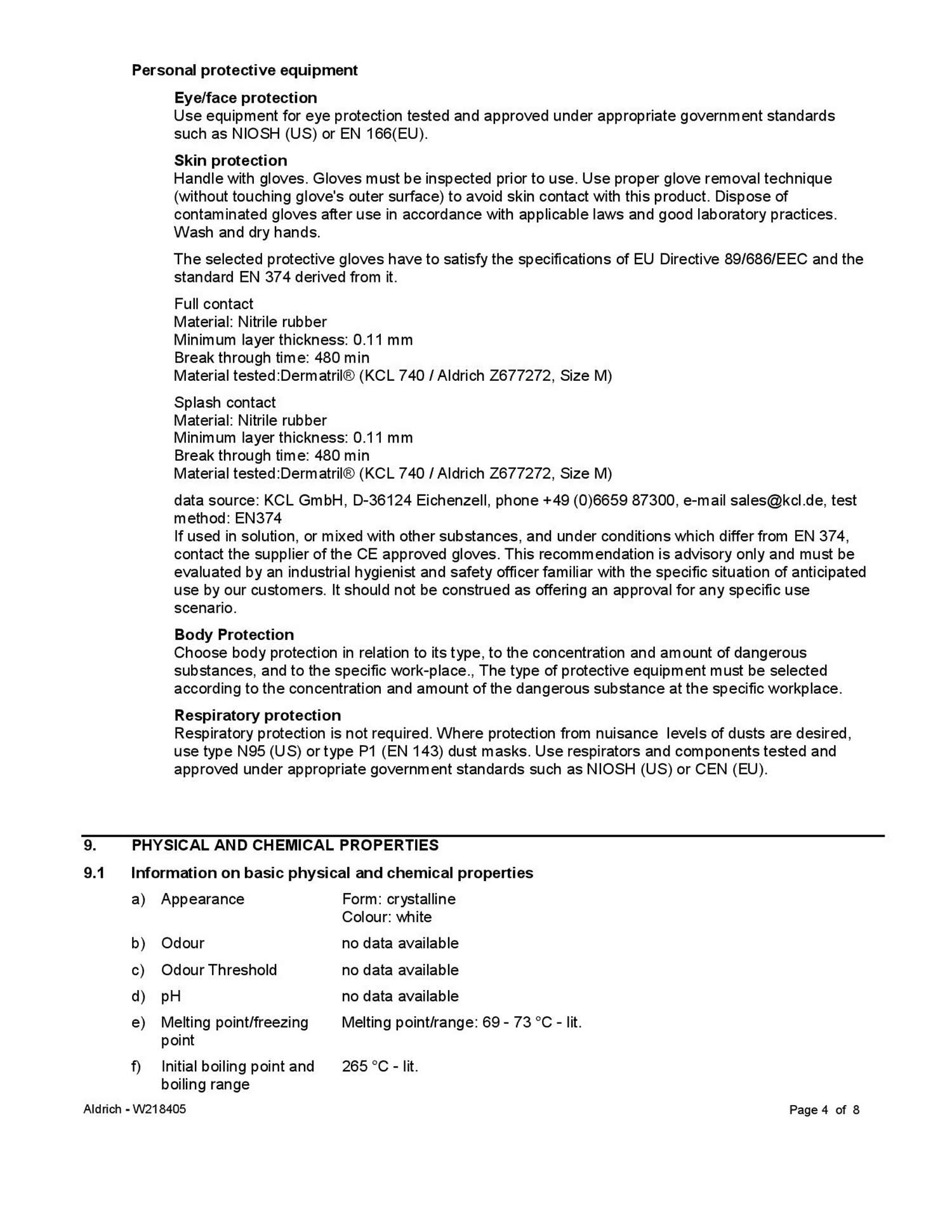

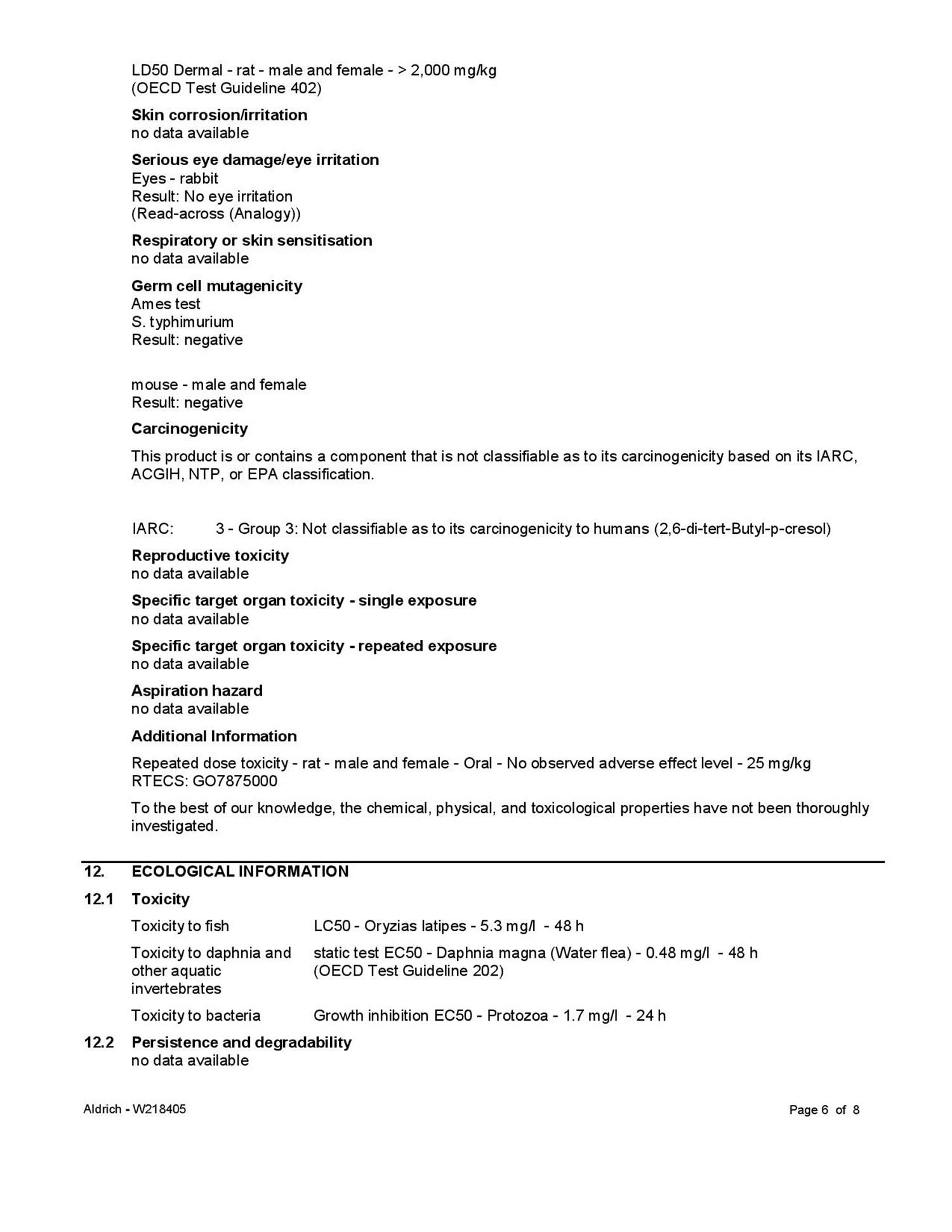

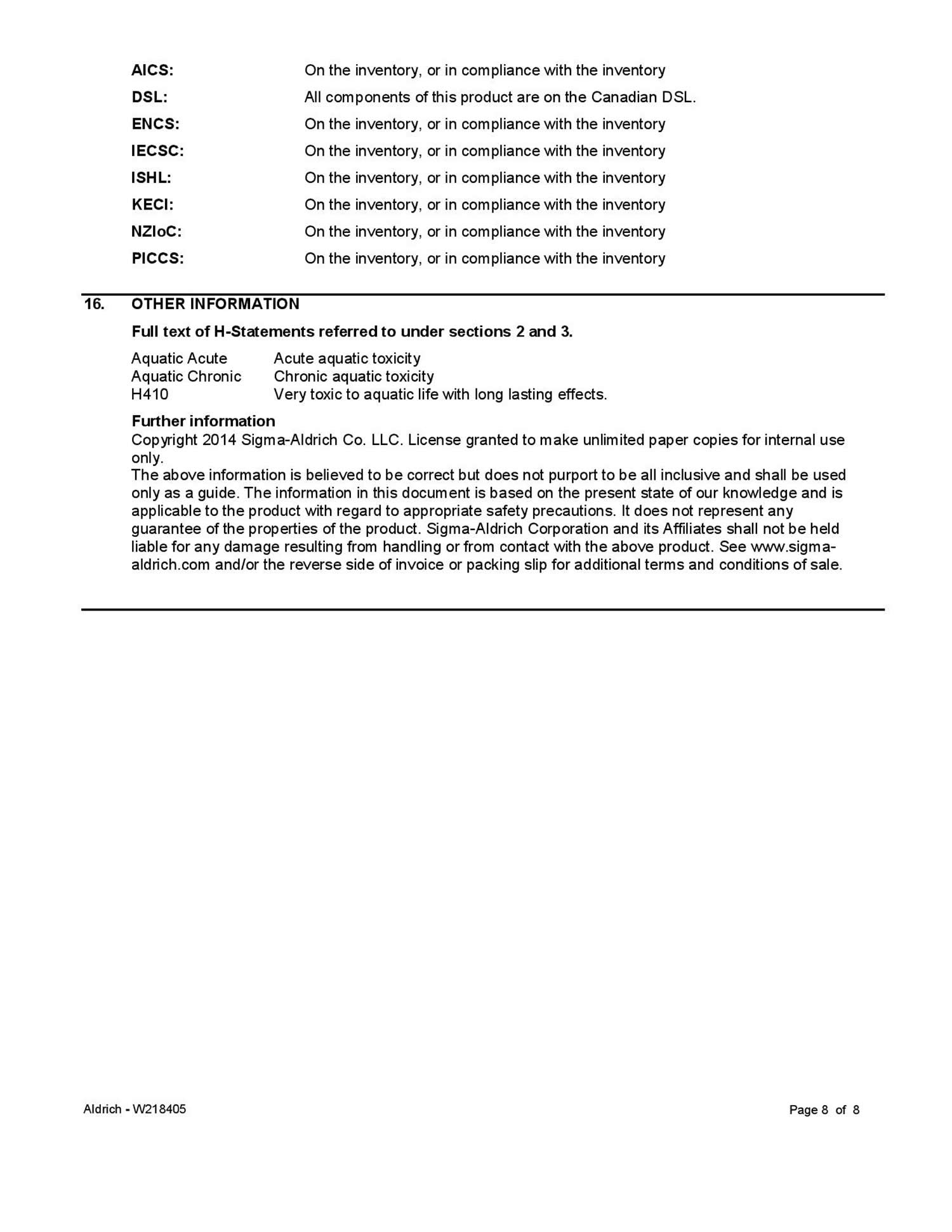
References [ + ]
Source: https://healthjade.net/butylated-hydroxytoluene/
Posted by: buenolabody.blogspot.com

0 Response to "Why Does Bht (Butylated Hydroxytoluene Have Gelatin Is Is Animal Based?"
Post a Comment